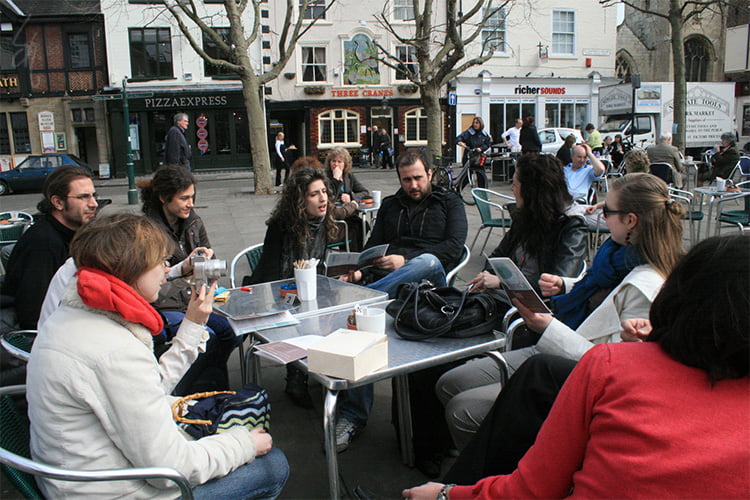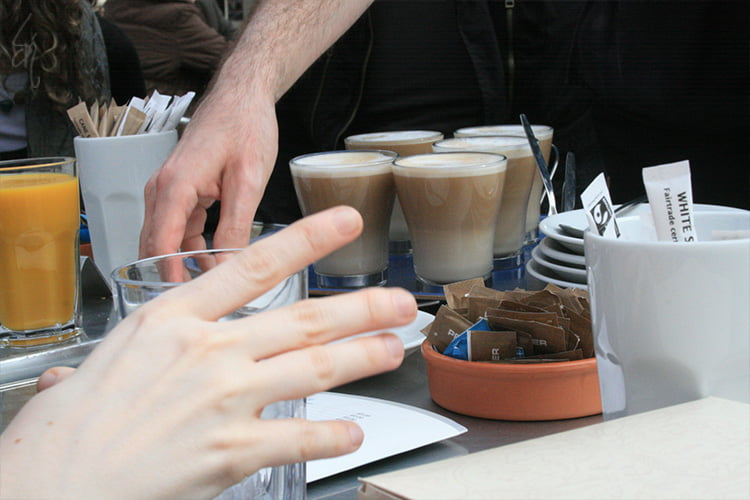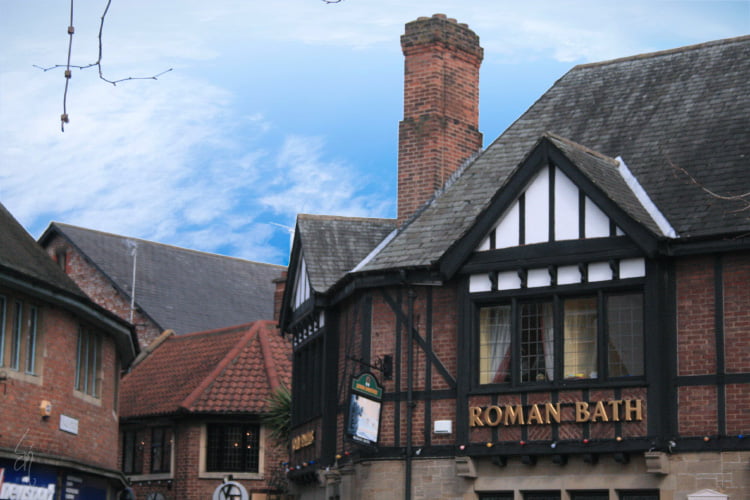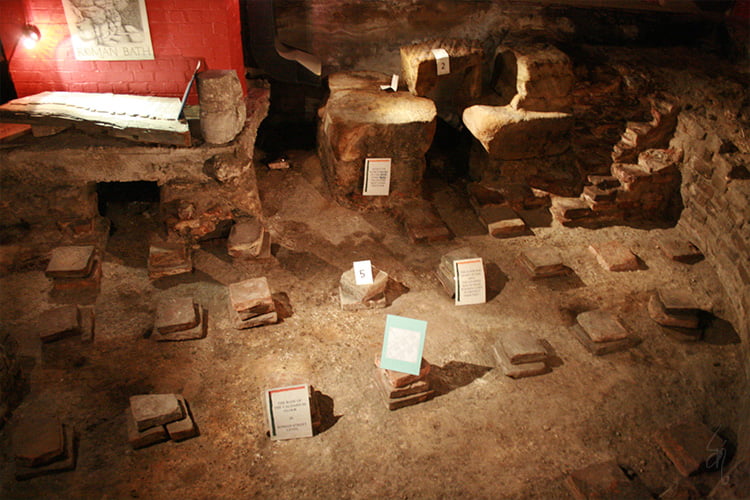Returning to York
This time I went with some of the girls from the HOFA class before we all fly off to our respective countries to spend Easter break. Also, this time the trip has a Roman Britain feeling to it–something that I didn’t do the last time. Scroll along to read what York was like in the Roman period. It was not York. It was Eboracum.

Easter is almost here. I booked my flight home to spend the Easter break in Indonesia and today I decided to join the girls and their beaus to hop on a train towards York. On this April Fools’ Day 2009, we got on to the morning train past Barnsley and Derby and arrived in York around 8 am. This wasn’t my first visit to York. I’m quite familiar with where to go from the station towards the Minster and the old part of town. Was it cold, you ask? Are you kidding? When is North Yorkshire ever not cold? But it was so lovely to be able to cross River Ouse again on that morning. I saw some flowers started to bloom reluctantly to welcome springtime. Presence of their colours helped with the bleak and grey sky that early morning. Look at those pictures… the sky persisted to stay as grey as it can and it’s such I-want-my-blanket-and-crawl-in-bed weather. But hey, in one week time I will get away from all of these shades of grey and return to the arms of the mighty bright sunshine.
Right from the beginning of the trip, I felt that the girls aimed for it to be a relaxed trip which I don’t mind. We just got over our anatomy finals and we need to have plenty of relaxing to keep our sanity. Most of us will be back to our respective countries to spend Easter break, so we thought we’d like to spend a relaxing time together.
We took our sweet time walking towards York Minster and this time I managed to look closer to the Guy Fawkes birthplace which now operates as an inn. I knew it was there when I first visit the area but hadn’t got the time to peek closer. Guy Fawkes was born in this exact place in 1570, was baptised in St Michael Le Befrey which is just across the street. Convenient, eh?
Now with Anglican services, the current façade of St Michael Le Befrey was built in 1525, replacing the original structure existed in 1294. I won’t be writing about Guy Fawkes assuming everybody knows who he is by now since V for Vendetta. There are plenty of resources available through the mighty machine called Google Search to find out more about who Guy Fawkes is.
We didn’t spend much time in York Minster. We didn’t even walk inside. I guess everyone’s bored with churches and architecture. I didn’t complain or comment cause I have had my time in the Minster before. We hurried away from the Minster and thought we might visit Jorvik. But guess what… One more time, I saw people queuing in a long line towards the entrance to Jorvik Viking Centre. Nope. Not again.
A little bit disappointed, we shifted our attention to bakeries selling Easter delicacies and watched some street performances. I drooled over those tiny weeny things displayed in the front window of a bakery. There were chocolates, macaroons, assortments of bread, bountiful of candies—oh gosh! Yes, I bought some. Of course! Why wouldn’t I? Well, then only to discover that macaroon is too sweet for me and I don’t like it. Looking around the spot where I was standing, I thought, what place in England that has no backstory? None of them.
This city is one of the richest with history. It reeks of the past, it emits nerve-racking tingles that brought you to think about the past. If it was possible, there were ghosts in and around me that talk about their stories. Imagine me having these feelings only by being in York. I haven’t got to Canterbury or Glastonbury yet.
The Romans stayed in the southern part of the island when they first arrived in Britain. But after the uprising led by Boudica of the Iceni, the Romans began to skirt up north. In 43 AD, the north was inhabited by a Celtic tribe known as the Brigantes and their queen at that time was Cartimandua. When the Romans arrive in her territory, she decided to play nice and become a Roman client state. But as leadership changes within the Brigantes brought up more hostility towards the Romans, Cerialis marched the Legio IX Hispana towards the north and then fortified York.
Eboracum was the name used to identify the York area in the Roman era. It was Brittonic in origin. The exact location of the city itself was founded in 71 AD when Cerialis arrived. He built—well, ordered his army to build a wooden fortress in a flat land near the confluence of River Ouse and River Foss. When Legio IX Hispana left Eboracum in 119 AD, they were replaced by Legio VI Victrix who made Eboracum as their headquarter (2,3). The site of the principia still lies underneath York Minster (not that I saw it, I read of it).
The place bloomed to become a metropolitan hub visited by Emperors Hadrian, Septimius Severus, and Constantius I. The latter died in Eboracum on 25 July 306 and declared his support to raise his son, Constantine the Great, to have full Augustus mode. A statue of Constantine the Great sits today nearby the location where he was proclaimed as an Augustus. By 400 AD Eboracum suffered occasional flooding from the Rivers Ouse and Foss and people started to relocate. After its decline, the city was taken over and inhabited by the Angles who came in the 5th century.
In the Anglo-Saxon time, the city area is known as Eoforwic and became the capital of the kingdom of Northumbria. By 866 AD, Eoforwic fell to the hands of the Danish Viking and came to the name Jorvik to identify the city. During the occupation of the Danes, Jorvik became the capital of the Kingdom of York. It was during this period that the city became a major river port as part of the extensive Viking trading routes throughout northern Europe. The last ruler of Jórvík was Eric Bloodaxe who was then driven out of the city by King Eadred.
The Roman Bath
Some of the girls threw in ideas that we should sit somewhere to get our dosages of caffeine and nicotine while figuring out where to go next. We chose a place which appeared to be known as St Sampson’s Square. I always love this part of finding out things without a map at hand—just let myself lost in the middle of the old town. History also piggybacked the place where we sat our pretty arses down. St Sampson’s Square dated back to the 12th century and was known as Arkilltofts. It was a large open space situated in the south-eastern corner of the former Roman fortress.
The square appears to have a long history as a business hub where merchants meet with customers and sell a variety of stuff. It was known as one of the two principal markets in the area and was known as Thursday Market in 1250. In the 14th century, Thursday Market was famous as a place of meat trading. It was also the main location for merchants who sell fabric, baked goods, wool, and other foodstuffs. By the 16th century, the market served the community three days a week (Tuesday, Thursday, and Saturday) and in 1593 a Friday market was opened to cater merchants selling linen. The name St Sampson’s Square was in used around 1836.
We’ve had good coffee, good times, good company. All we need now is a destination. I forgot who then pointed out the “Roman Bath” signage across the square and we agreed to see what the place has to offer. It was a pub. Going into a pub at 11 am is alien to me. But no… I was mistaken. It wasn’t only a pub. It’s an archaeological site, a museum, a hotel, and a restaurant as well. Talk about multi-use site, eh? I remember I was confused cause I thought the girls wanted to sit in a pub at this wee hour.
As we entered the establishment, we were greeted by a stair heading fifteen feet underneath the pub. I must admit that I didn’t know what to expect when I get downstairs. As I put my last foot on the ground, I realised that I am somewhere else. It’s another world that smelled damp, cold, but beautifully lighted—a small museum in an actual archaeological site. I nearly fell over cause it felt as if I had crossed over to the Roman era. Perhaps, this was the closest feeling I have to experience time travel. Imagine, me—a whimsy tropical girl visiting a Roman bath 2,000 years ago—I would be so out of place. Today, I guess me and the girls put off our archaeologist hats and turned ourselves into cheery tourists in an attraction.
The current establishment is situated on top of the remnant of a Roman bathhouse, and it is called The Roman Bath. Pretty obvious for a namesake. It has a Tudor-Revival style façade with applied half-timbering as its exterior. After rigorous excavation and research, it was concluded that this bathhouse used to serve military personnel of Eboracum. Legio IX Hispana was possibly the one who initially constructed the bathhouse.
The site has changed functions over the years of its existence. In 1930, the location was known as Mail Coach Inn, and the pub itself is listed as Grade II building since 1954. The Roman Bath is an area of around 200 sqm situated between St Sampson’s Square and Swinegate. Remnants of a Roman sewer system were found in Swinegate. Excavation results conclude that the bathhouse was built between 71-122 AD.
That’s about the same year when Cerialis and his Legion IX Hispana founded Eboracum. Also, the same time when Cerialis and the Legio IX Hispana started the construction of the castra in River Ouse. Makes sense, though. Romans were known to adhere to the concept of hygiene, including bathing frequently. So, if they were to move and settle in some place, they most probably will bring or build infrastructures supporting their lifestyle.
Inside the bathhouse, we can observe only the caldarium and frigidarium, though. The tepidarium is undiscovered (yet). It must be around there somewhere, but I think the surrounding structures are too dense to detect or excavate more of Roman foundation works. Plus, it’s a working pub anyway. We don’t want them to close down or have limited service due to excavation, right? Perhaps it’s best to leave it this way. Not everything must be uncovered, and there must be some other sites in England that have all three features of a Roman bathhouse.
Visitors can have a go at replicas of Roman-style weaponry and armoury displayed in a corner. You can dress yourself as a Roman soldier and take loads of pictures. It was so fun to try it on. Of course, it was weird for me to try a Roman helmet on. It didn’t fit at all because—get ready—I’m too small. A small part of the mini-museum displays other artefacts as well, though not too many of them. We spent quite some time down in the mini-museum.
A lovely man who was our guide accompanied us, and I thought he’s a good storyteller. I remember keeping a mental note when I listened to him. He’s enthusiastic. We need more guides who are as enthusiastic as he is. As we went upstairs, there was a placard stating YOU HAVE JUST STEPPED DOWN THROUGH 2,000 YEARS OF HUMAN OCCUPATION. How cool is that? Well, I just got back from 71 AD Roman York.
York's Old Town
Upstairs, the 21st century greeted us with very little sunshine. We were tired and hungry when we got out of the Roman bathhouse. Saying goodbye to 2,000-year-old of history, we headed to the Shambles for a bite or two or three. Pretending being a Roman soldier taking a bath in a Roman bathhouse is quite tiresome. At this point, I wasn’t really paying attention that the cobbled street I walked on dated back to the 14th century.
We made a quick stop at King’s Manor out of curiosity just because it was on our way back. King’s Manor is—of course—the Department of Archaeology for the University of York. Where else would a bunch of archaeology students go on an off day? The building was built to house the abbots of St Mary’s Abbey, but then after the Dissolution, Henry VIII instructed it to become the main seat of the Council of the North. Today, the Centre for Medieval Studies and the Centre for Eighteenth-Century Studies are also housed in the same building.
I was so hungry until we finally sat down in a restaurant somewhere nearby the Shambles. Quite possibly it was in Stonegate—but I can’t remember. An hour lunch break and then we’re off again through the Shambles towards Clifford’s Tower.
The Shambles’ record can be traced back to the Domesday Book even though it wasn’t mentioned as “The Shambles”. In the Book, it was noted to have only two butcher stalls belonging to the Count of Mortain. I loved the Shambles and how narrow the cobbled pavements are. Perhaps because I walked on it in the 21st century and not back in the day where it’s so dirty and smelly with meat stalls and whatnot. I still love it, though. It’s so… English.
I’ve covered the Clifford’s Tower from my last visit to York, so I won’t add anything here. Believe me you, and nothing changes in Clifford’s Tower since last October apart from the blooming yellow flowers around the mound. It was afternoon when we got there, and we decided to head back to the railway station and catch a train home. But before that, of course, the must-have dosages of caffeine and nicotine in the bank of River Ouse.
This time we sat down in the outside tables of The Lowther across Woodsmill Quay. Another sitting setting, another history? Yes, indeed. Woodsmill Quay (now Apartment) is located in a section within the city walls of York known as Bishophill which dates back to 1334. The building was constructed in the 19th century and was used as a timber mill.
By 2000, it was gentrified and turned into an apartment which can be booked here. It now offers “spacious living/dining room with maple floor, deep window seats (nestling within the original mill walls) with river views and well-equipped kitchen area.” But I already have a flat in Sheffield.
This trip to York was certainly decorated with different vibes than my last visit. Nevertheless, I enjoyed it so much cause I’m spending times with the girls that are not in the laboratory setting. I have a plane to catch next week, and I probably want to spend time rummaging through the first draft of my first thesis chapter beforehand. Once again, I said goodbye to York, never knowing when I will be back.
References
1. Cunliffe, Barry. 2013. Britain Begins. Oxford: Oxford University Press. Available at Abebooks UK.
2. Tillott, PM. (ed.) 1961. A History of the County of York: the City of York. British History Online.














